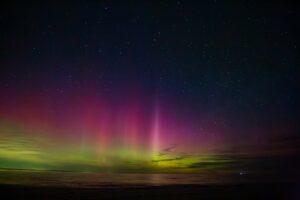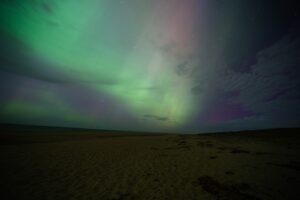WELLFLEET — On hearing there was a solar storm on the way, Jeremy Storer went online to find maps of where the northern lights might appear for those of us living on Outer Cape Cod. Taking pictures of the night sky is a recent interest, says Storer, who felt lucky to have been learning his way around his full-frame camera when the aurora borealis came along last weekend.

“I didn’t get a lot of sleep,” says Storer, who is by day a Wellfleet shellfisherman. “But I didn’t want to miss this opportunity to see the lights.” He spent hours at Race Point on Friday and Saturday nights, with family in tow, then late Sunday and in the wee hours of Monday watched alone from Newcomb Hollow Beach in Wellfleet.
That first night, Storer says, they were joined by only a few others, looking up in the darkness and hoping to see the aurora, though later in the weekend, more people turned out. You can’t know exactly when the lights will appear. “It takes patience,” he says.
The camera, fitted with a wide-angle lens, exaggerates the aurora’s effect, Storer says, because of the way it gathers the light. What he saw varied from one night to the next. On Friday at Race Point, the lights were “intense and flashing,” while in Wellfleet it was “hard to describe.”

The sun emits a steady stream of charged particles called the solar wind, says Justin Samaha, the Independent’s astronomy columnist, who we called on for an explanation of the phenomenon. These electrons, protons, and alpha particles would present a dangerous radiation hazard, but Earth’s magnetic field protects us by deflecting the particles around the atmosphere.
Occasionally the solar wind flares up powerfully and the particles break through weak spots in our magnetic field at the north and south magnetic poles. When they strike molecules of nitrogen and oxygen in the upper atmosphere, those molecules are energized by the impact and the release of that energy takes the form of visible light.
“The different colors correspond to different gases and energy states,” Samaha says. “Aurorae are normally visible only in the highest latitudes. But when solar activity is unusually strong, as it was last weekend, those of us farther south can see the eerie, beautiful spectacle.
“One of my favorite science-fiction disaster movies, The Core, is about what happens if Earth’s magnetic field shuts down completely. It’s great fun even if the science is absurd,” says Samaha.



